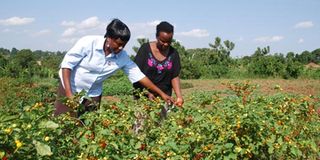Discovering the secret in indigenous vegetables

Dr Elizabeth Kizito (left) and Pamela Kabod (right) inspect a mother garden for vegetable multiplication at a demonstration site in Mukono. PHOTO BY OTUSHABIRE TIBYANGYE
What you need to know:
Dr Agnes Nantambi of Makerere University points out if vegetables are not well handled, they lose nutritional value yet they are a good source of iron, zinc and vitamin A
Many people love to eat vegetables because of their availability all year round as well as their easy-to-cook and fast growing nature.
Demand for indigenous vegetables is very high especially in urban areas in various parts of the country.
This has attracted a keen interest for improvement and preservation.
Against this background, the Department of Agriculture and Biological Sciences, Uganda Christian University (UCU) together with School of Food Technology and Nutrition, Makerere University are carrying out research on nutritional value and shelf life of indigenous vegetables.
The focus is on especially nakati (Solanace), buga, dodo (Amaranthus) among others, which are common in eastern and central Uganda.
The principal investigator, Dr Elizabeth Kizito of UCU, says the objective is to generate knowledge, work on the germ plasm, post-harvest handling technologies, improve varieties and get better seeds.
Handling after harvest
The other angle to the project is to bring on board different actors in the value chain especially at post-harvest level.
The research is going on in Mbale, Jinja, Buikwe and Wakiso districts with the field characterisation and multiplication at UCU Mukono campus.
Dr Agnes Nantambi of Makerere University points out if vegetables are not well handled, they lose nutritional value yet they are a good source of iron, zinc and vitamin A.
“The vegetables are very good for the average person because animal proteins are expensive,” she says.
Most losses are registered during transportation and packaging are high due to short shelf life.
There is need for improved packaging like wooden crates, polythene bags (buveera) or plywood.
Packaging will minimise post-harvest handling losses, transportation and shelf life.
Steven Sepulya, a postgraduate student from Makerere University attached to the project, is doing an assessment of different packaging materials.
Some of these are perforated polyethylene bags and nylon meshed bags at ambient, cold room and low-cost charcoal cooler conditions.
The tested and approved technologies that enhance the shelf life of screened Solanace and Amaranthus species will be recommended to farmers.
For high value markets, there is need for cold storage chain, natural atmosphere and refrigeration.
Makerere University’s School of Food Technology and Nutrition has developed a charcoal cooler, which can preserve vegetables for up to six days.
The cooler is a small room with charcoal walls and a a wooden frame, which supports the walls and roof.
The walls are constructed from a wooden frame covered with wire mesh separated by about 10 cm with the interior being filled with charcoal. The walls are on all four sides, filled up to the top 15 to 20 cm below the roof, with this space being left open so as to allow air circulation.
Charcoal is used because it has a porous structure that can hold water, is a material that is easily affordable and available in many locations.
Ordinarily, harvesting vegetables for the market is done in the evening to minimise the losses and bundled in packages of 80kg-100 kg and is transported in the night.
Looking for varieties, which have a long shelf life so as to keep the quality, is thus the need for the coolers.
“We have been able to biochemically characterise the nutritional value of many indigenous vegetables and have found out that they (vegetables) score highly compared to the excotic breeds,” Dr Kizito says.
Good practices
They compete favourably with carrots, sukuma wiki and cabbage, among others. They need less spraying as they are adopted to the local environment thus giving better health benefits to the farmers and consumers alike.
They grow all the year round especially around Lake Victoria region and wetlands.
Pamela Kabod, a PhD student at UCU, says she is looking for medicinal properties in the indigenous vegetables as the last phase of the project.
Farmers have learnt the importance of good agronomic practices like crop rotation, seed bed preparation and proper spacing.
They have been able to learn about the different varieties of vegetables that exist.
And also that the use of pesticides is not the only and best way to control pests in their fields.
A case in point
Nakati has been identified as a short-cycle crop because it is consumed at the earliest opportune time before it flowers and matures very fast. It is also on high demand in urban centres.
Dr Kizito says it is ready for harvest at eight weeks after planting. “In a year, a farmer can plant three to four times especially in wetland areas where it can be grown all the year round,” she says.
It brings in a lot of gains better than crops such as maize in any given season.
Compared to the investment and time, an acre of nakati is capable of bringing in $2,000 (Shs6.6m) per harvest.




